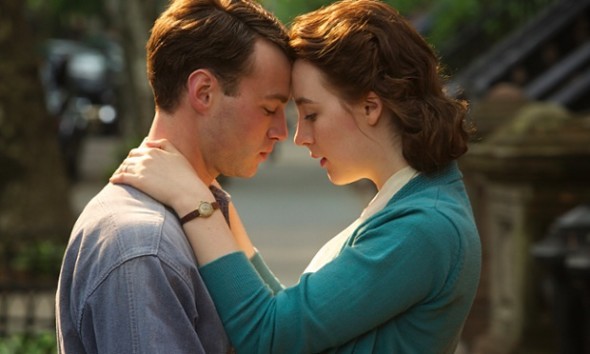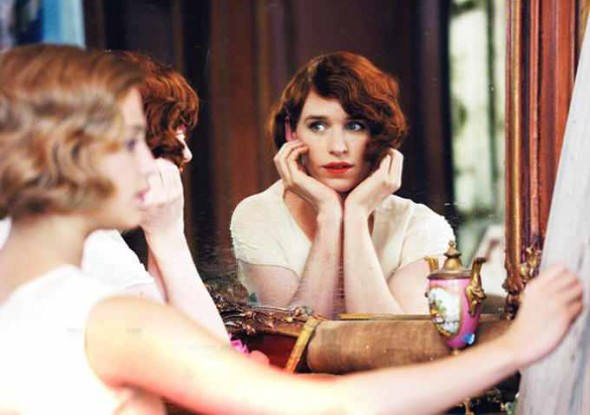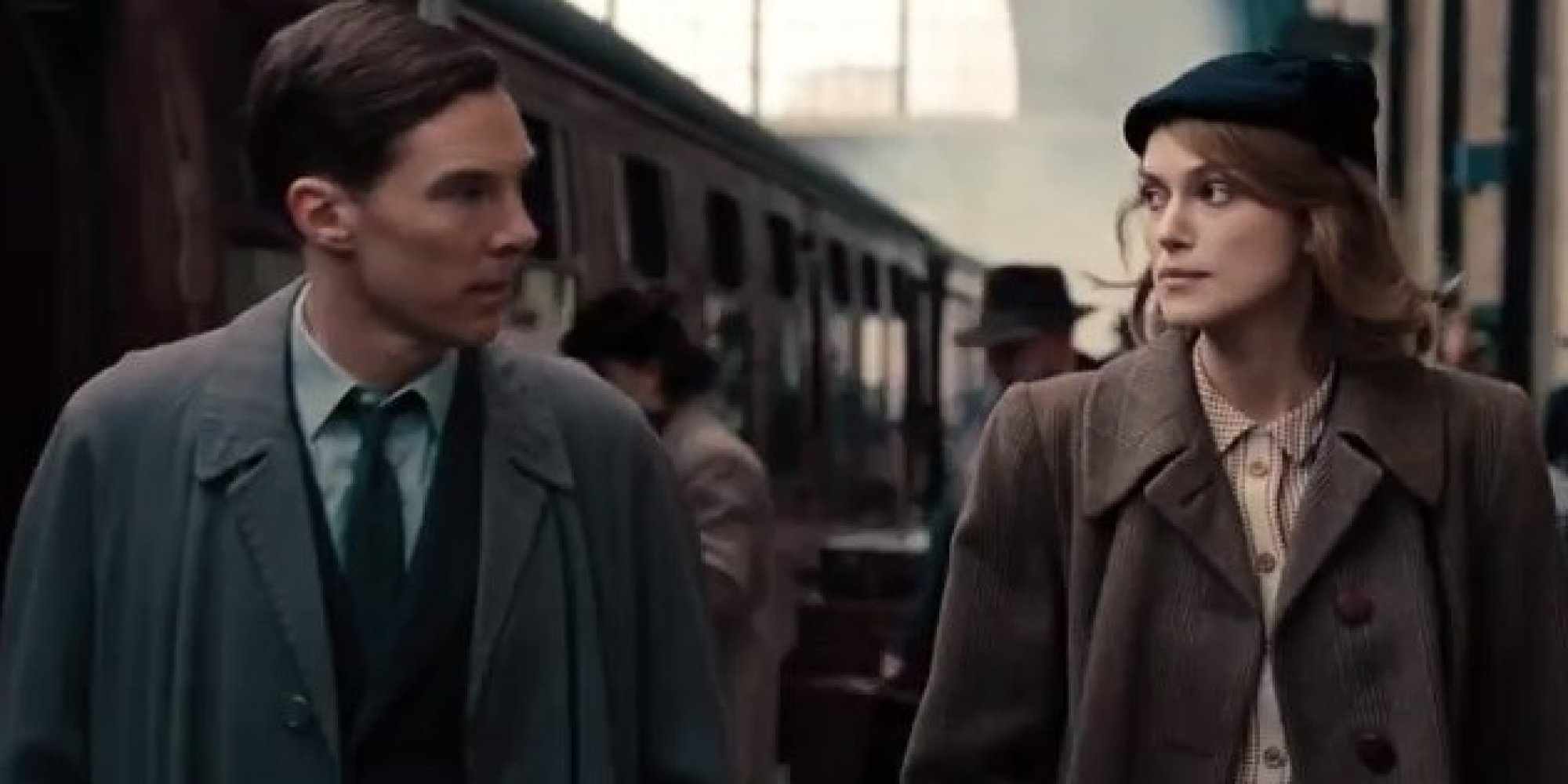I’m never enamored of the cleaned-up, ambiguity-free nostalgia that movies, especially mainstream ones, serve to their audiences in the guise of “history” so I avoided John Crowley’s Brooklyn (written by Nick Hornby from the novel by Colm Tóibín) about an Irish immigrant, Eilis (Saoirse Ronan) in the US. The Irish have been romanticized in films as early as The Quiet Man (a new release when the film takes place) and romanticized among Irish Americans for as long as the Irish have been coming to the US. But when Brooklyn began raking in awards (especially for Ronan) I decided to see it.
I was surprised at how enjoyable and skillfully made Brooklyn is: I cried when everyone else did and gasped when the rest of the audience did too, but in spite of its excellent art direction and affecting performances the film is mostly hokum. New York in the 1950s is a place where no one the main character hangs out with smokes (when all of the men and the majority of women were smokers). Most of the characters barely drink (just one glass at Christmas) and, except for a child’s brief outburst at a family dinner table, (“I should say that we don’t like Irish people”) none of its white, working-class, ethnic characters have any problem with any other ethnic group. In the actual 1950s, my mother, just a few years younger than Eilis is in the film, lived in an Irish American neighborhood in Boston, much like the one the film shows in New York and wasn’t allowed to date Italian boys because, her father explained, “They beat their women.” We never find out what the main characters in Brooklyn think of Jewish people (since the church still taught then that the Jews killed Christ, that opinion probably wasn’t favorable) because none of them encounter any, even though plenty of Jewish people lived in Brooklyn in the 1950s. And Black people in this film are at the farthest periphery: two women in a crowd crossing a street and a Black couple is shown on the beach at Coney Island.
Eilis’s family in small-town Ireland is prosperous enough that her sister works as a bookkeeper and they live with their mother in a decent house, but Eilis immigrates anyway to a sales clerk job, arranged by a kindly priest (Jim Broadbent), at a department store in New York. In other words, she’s the kind of immigrant even the Republican party of today would like: white and “respectable.” She’s not the kind who comes to the country without papers, or has to learn English, scrub floors or work as a nanny and she doesn’t have an impoverished family in her home country to worry about. When being well-cared-for in her new home becomes too much for Eilis, her suddenly sympathetic boss (Jessica Paré) has the priest swoop into the store break room and tell Eilis he’s signed her up for bookkeeping classes at Brooklyn College. He tells her, “Homesickness is like most sicknesses. It will pass.”
Priests in the US at the time took collection money from their parishioners and gave them very little in return so to have one dole out college tuition after arranging a sales clerk job seems far-fetched, and for the recipient of both favors to be a young “marriageable” woman the priest barely knows seems like something from a parallel universe. For women in the 1950s, especially those in the working class (even ambitious ones like Eilis) the endgame was marriage, not a career. “Real” men (especially working-class ones) didn’t let their wives work outside the home (unless the family was poor), but Eilis’s middle-class, Italian-American, plumber boyfriend (Emory Cohen, a standout in a very good cast) walks her home from her night classes and loves hearing about her studies. His parents and his brothers seem equally charmed instead of exchanging nervous glances and asking, “You’re not a career girl, are you?” The only way a daughter-in-law in that type of family in the 1950s could work would be in her husband’s business — and even then she probably wouldn’t be given a salary for the first decade or so.
What priests did then (and for decades afterward) was browbeat women for working when they had children at home: if they encouraged women to go to college, the goal was for the women to find husbands there and never work outside the home again. If their husbands then beat or neglected them, the priests told the women they must be at fault (this mindset was a secular one at the time too) and they must never, ever get divorced. At the boarding house where Eilis lives she talks about marriage with a woman whose husband has left her for “someone else.” We never have a clue, in all of Eilis’s longing for her old hometown that a woman in that same situation wouldn’t be able to get divorced in Ireland until the very last part of the 20th century, a detail that a woman screenwriter or director probably wouldn’t leave out.
[youtube_sc url=”https://www.youtube.com/watch?v=15syDwC000k” iv_load_policy=”3″]
Sarah Gavron’s Suffragette (with a screenplay by Abi Morgan) is another film I put off watching, because even with its creaky plot device of seeing historical events through the eyes of a fictional “composite” character the film apparently still managed to leave women of color out of the fight for British women’s suffrage as well as omitting another integral element, the queerness of some of the most famous suffragettes.
The film isn’t as bad as I feared it might be (or perhaps it just looked good compared to the film I saw just before it: The Danish Girl) but its problems are not just because it’s about white, straight women. Carey Mulligan does what she can with the lead role, Maud, who works at the laundry and is radicalized by a coworker–and by witnessing police beating up “Votes for Women” protesters. The film could do a much better job of integrating present-day concerns with what happened to “radicals” then, with its scenes of not just police brutality and political groups using bombs and violence as a means to bring about change, but the treatment of political prisoners and the force-feeding of hunger-strikers.
We see Helena Bonham Carter in another old-fashioned role: the audience/main character’s guide to the movement but we don’t see what we do in Brooklyn’s portrait of the women in the boarding house: the sense of the group of women as a clique, a cornerstone of the women’s suffrage movement which needs to exist in any radical political movement. If a woman’s family and old friends think her ideals are anathema, she needs to find peers who share those ideals and who will be her new friends — and new family. Except for a few, not very compelling scenes, we don’t get the sense of Maud as part of a group that supports her, just that she’s an outcast from her old life. The film contains very little we haven’t seen before and what’s new in it is allowed onscreen only very briefly: like the idea that Maud, who has worked most of her life including her childhood, would find motherhood her first opportunity to engage in play.
The film instead becomes a guessing game of what horrible thing can happen to Maud next. Suffragette has the chance to contain more dramatic tension when a police captain asks her to be an informant in exchange for dropping charges (another situation with present day parallels). He tells his men, “We’ve identified weaknesses in their ranks. We’re hoping one of them will break.”
But instead of considering the offer or pretending to inform while acting as a double-agent, Maud just writes an impassioned letter to him about the righteousness of her cause. In the end, Maud is just as dull and unimaginative as the film is, which is a shame, because the real-life figures in this fight were never boring.
[youtube_sc url=”https://www.youtube.com/watch?v=056FI2Pq9RY” iv_load_policy=”3″]
___________________________________________________
Ren Jender is a queer writer-performer/producer putting a film together. Her writing, besides appearing every week on Bitch Flicks, has also been published in The Toast, RH Reality Check, xoJane and the Feminist Wire. You can follow her on Twitter @renjender
















